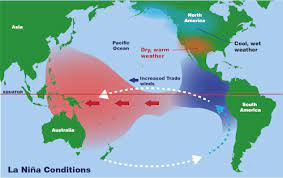La Niña:

The Australian Bureau of Meteorology on September 13 confirmed the occurrence of La Niña phenomenon for the third consecutive year in the Pacific Ocean.
- The World Meteorological Organisation (WMO) on August 31 had stated that the oceanic and atmospheric phenomenon would last until at least the end of the year, and for the first time this century, span three consecutive northern hemisphere winters to become a ‘triple dip’ La Nina.
- El Nino and La Nina, which mean ‘the boy’ and ‘the girl’ in Spanish, are mutually opposite phenomena, during which an abnormal warming or cooling of sea surface temperatures is observed in the Pacific Ocean along the equator, off the coast of South America.
- Together they constitute what is known as the El Niño-Southern Oscillation system, or ENSO for short.
- ENSO conditions can alter both temperatures and rainfall globally, due to their strong interference on global atmospheric circulations.
- It is a recurring phenomenon and the change in temperature is accompanied by changes in the patterns of upper and lower level winds, sea level pressure, and tropical rainfall across the Pacific Basin.
- Normally, El Nino and La Nina occur every four to five years.




